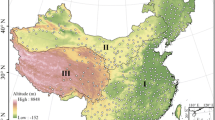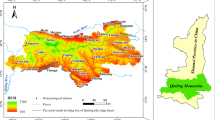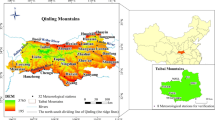Abstract
The warming rates in China determined by daily minimum temperature (Tmin) are considerably large than those based on daily mean temperature (Tmean); therefore, the thermal growing season indices defined from Tmin are expected to show more pronounced changes than those from Tmean. In this study, we investigate changing rates in the local growing season (LGS) defined using the climatological annual mean Tmin and Tmean as temperature thresholds throughout China for the period 1961–2012. Changes in the thermal growing season indices based on fixed-temperature thresholds such as 0 °C, 5 °C, and 10 °C are analyzed for comparison. Results show that the Tmin-based LGS-lengthening rate (3.0 days per decade) is at least 1.2 times that of the Tmean-based result (2.5 days per decade). It is also suggested that the growing season defined via a fixed-temperature threshold should only be applicable when determining the validity of a particular station in relation to its location. For example, the 0 °C-, 5 °C-, and 10 °C-based growing season definitions are applicable in regions to the north of 36° N, 32° N, and 26° N, respectively, based on Tmean in eastern China and to the north of 33° N, 27° N, and 24° N, respectively, based on Tmin. To the north of 35° N in China, the average Tmin-based growing season lengthening rates are about 1.3, 1.4, and 1.7 times of those Tmean-based rates in case of using the fixed-temperature thresholds of 0 °C, 5 °C, and 10 °C, respectively. Therefore, the changes of the growth of some plant species that are more directly correlated with changes in Tmin should be much more pronounced than those of other species.




Similar content being viewed by others
References
Abu-Asab MS, Peterson PM, Shelter SG, Orli SS (2001) Earlier plant flowering in spring as a response to global warming in the Washington, DC, area. Biodivers Conserv 10:597–612
Alexander LV, Zhang X, Peterson TC, Caesar J, Gleason B et al (2006) Global observed changes in daily climate extremes of temperature and precipitation. J Geophys Res 11:D05109
Alward RD, Detling JK, Milchunas DG (1999) Grassland vegetation changes and nocturnal global warming. Science 283:229–231
Chen HL, Liu YJ, Du ZX, Liu ZY, Zou CH (2011) The change of growing season of the vegetation in Huanghe-Huaihe-Haihe region and its responses to climate changes. J Appl Meteor Sci 22(4):437–444
Christidis N, Stott PA, Brown S, Karoly DJ, Caesar J (2007) Human contribution to the lengthening of the growing season during 1950-99. J Clim 20:5441–5454
Dai JH, Wang HJ, Ge QS (2014) The spatial pattern of leaf phenology and its response to climate change in China. Int J Biometeorol 58:521–528
Dong MY, Jiang Y, Zhang DY, Wu ZF (2013) Spatiotemporal change in the climatic growing season in Northeast China during 1960–2009. Theor Appl Climatol 111:693–701
Huang NE, Wu Z (2008) A review on Hilbert-Huang transform: method and its applications to geophysical studies. Rev Geophys 46:RG2006
Huang NE, Shen Z, Long SR, Wu MC, Shih EH, Zheng Q, Tung CC, Liu HH (1998) The empirical mode decomposition and the Hilbert spectrum for nonlinear and nonstationary time series analysis. Proc Roy Soc Lond A 454:903–995
Jeong SJ, Ho CH, Brown ME, Kug JS, Piao S (2011) Browning in desert boundaries in Asia in recent decades. J Geophys Res 116(D2):D02103
Jiang F, Hu R, Zhang Y, Li X, Tong L (2011) Variations and trends of onset, cessation and length of climatic growing season over Xinjiang, NW China. Theor Appl Climatol 106:449–458
Li Z, Yan ZW (2009) Homogenized daily mean/maximum/minimum temperature series for China from 1960—2008. Atmos Oceanic Sci Lett 2(4):1–7
Liu X, Yin ZY, Shao X, Qin N (2006) Temporal trends and variability of daily maximum and minimum, extreme temperature events, and growing season length over the eastern and central Tibetan Plateau during 1961–2003. J Geophys Res 111:D19109
Liu BH, Henderson M, Zhang YD, Xu M (2010) Spatiotemporal change in China’s climatic growing season: 1955-2000. Clim Chang 99:93–118
Manton MJ, Della-Marta PM, Haylock MR (2001) Trends in extreme daily rainfall and temperature in Southeast Asia and the South Pacific: 1961-1998. Int J Climatol 21:269–284
Menzel A (2003) Phenological anomalies in Germany and their relation to air temperature and NAO. Clim Chang 57:243–263
Piao SL, Fang JY, Zhou LM, Ciais P, Zhu B (2006) Variations in satellite-derived phenology in China’s temperate vegetation. Glob Chang Biol 6:407–416
Piao SL, Wang XH, Ciais P, Zhu B, Wang T, Liu J (2011) Changes in satellite-derived vegetation growth trend in temperate and boreal Eurasia from 1982 to 2006. Glob Chang Biol 17(10):3228–3239
Qian C, Fu CB, Wu ZH, Yan ZW (2009) On the secular change of spring onset at Stockholm. Geophys Res Lett 36:L12706
Qian C, Wu Z, Fu CB, Zhou TJ (2010) On multi-timescale variability of temperature in China in modulated annual cycle reference frame. Adv Atmos Sci 27(5):1169–1182
Qian C, Fu CB, Wu Z, Yan ZW (2011) The role of changes in the annual cycle in earlier onset of climatic spring in northern China. Adv Atmos Sci 28(2):284–296
Robeson SM (2002) Increasing growing-season length in Illinois during the 20th century. Clim Chang 52:219–238
Scheifinger H, Menzel A, Koch E, Peter C (2003) Trends of spring time frost events and phenological dates in Central Europe. Theor Appl Climatol 74:41–51
Shen MG, Zhang GX, Cong N, Wang SP, Kong WD, Piao SL (2014) Increasing altitudinal gradient of spring vegetation phenology during the last decade on the Qinghai-Tibetan Plateau. Agric For Meteorol 189:71–80
Sneyers R (1990) On the statistical analysis of series of observations. WMO Technical Note No. 143. Secretariat of the World Meteorological Organization, Geneva
Song YL, Linderholm HW, Chen D, Walther A (2010) Trends of the thermal growing season in China, 1951-2007. Int J Climatol 30:33–43
Szentimrey T (2008) Development of MASH homogenization procedure for daily data. In: Lakatos M, Szentimrey T, Bihari Z, Szalai S (eds) Proceedings of the fifth seminar for homogenization and quality control in climatological databases. WCDMP-No. 71. World Meteorological Organization, Budapest, pp 123–130
Wu Z, Huang NE (2009) Ensemble empirical mode decomposition: a noise-assisted data analysis method. Adv Adapt Data Anal 1:1–41
Xia JJ, Yan ZW, Wu PL (2013) Multidecadal variability in local growing season during 1901-2009. Clim Dyn 41(2):295–305
Xu MZ, Ren GY (2004) Change in growing season over China: 1961-2000. J Appl Meteor Sci (in Chinese, with English abstract) 15(3):306–312
Yang XC, Tian Z, Chen B (2013) Thermal growing season trends in east China, with emphasis on urbanization effects. Int J Climatol 33:2402–2412
Zhang GL, Zhang YJ, Dong JW, Xiao XM (2013) Green-up dates in the Tibetan Plateau have continuously advanced from 1982 to 2011. Proc Natl Acad Sci U S A 110(11):4309–4314
Funding
This work was supported by the National Key Research and Development Program of China (Grant No. 2016YFA0602503).
Author information
Authors and Affiliations
Corresponding author
Additional information
Publisher’s Note
Springer Nature remains neutral with regard to jurisdictional claims in published maps and institutional affiliations.
Rights and permissions
About this article
Cite this article
Xia, J., Jin, S., Yan, Z. et al. Shifts in timing of local growing season in China during 1961–2012. Theor Appl Climatol 137, 1637–1642 (2019). https://doi.org/10.1007/s00704-018-2698-8
Received:
Accepted:
Published:
Issue Date:
DOI: https://doi.org/10.1007/s00704-018-2698-8




